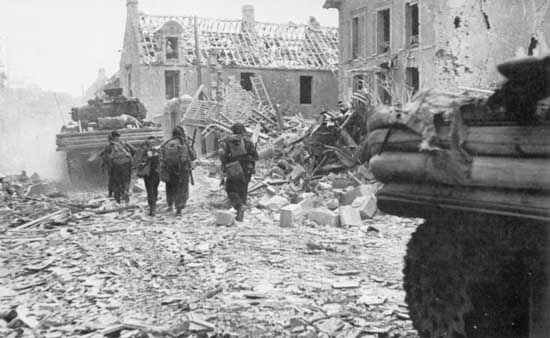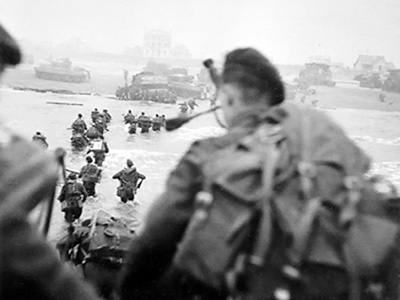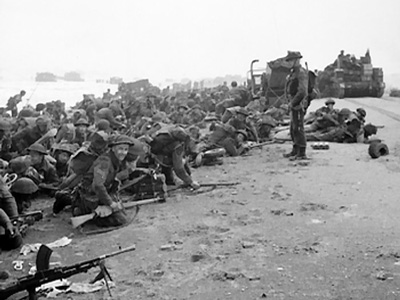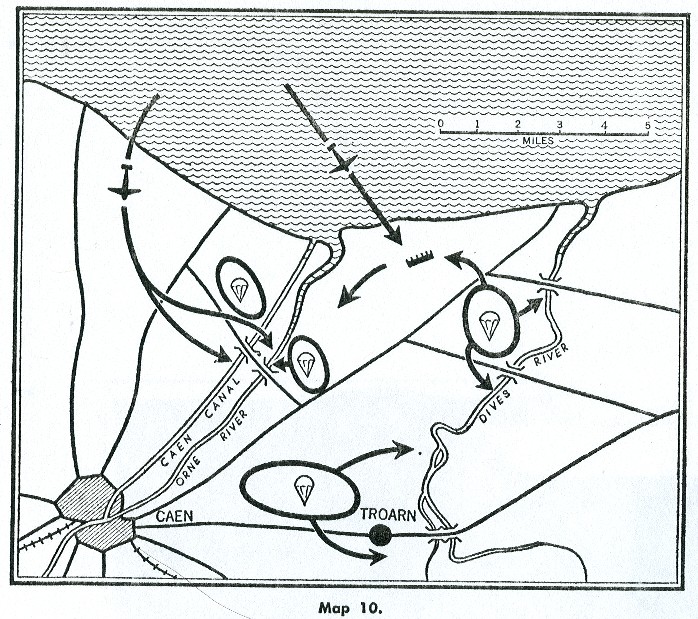Sword Beach Landings on D-day

I've been reading up on D-Day with regards the Sword Beach Landings. I have chosen this landing for our D-Day Commemorative game mainly because the bulk of my 20mm infantry models are British, and I don't think I'll have enough time to paint up my US troops. I have enough Airborne and commando models to include the airborne assault. My allied armour has been left without national and unit identification markings on purpose, so that they can be used on the Eastern front and for US troops as well. I will have to build some Hobart's Funnnies, as I don't have neither Crab or Crocodiles nor AVREs. We will use FoW rules, as my models are based for this rule set.

Sword Beach
SWORD BEACH was the objective of 3rd (British) Infantry Division. They were to advance inland as far as Caen, and line up with British Airborne forces east of the Orne River/Caen Canal. The Orne River bridges had been seized in late at night on the 5th of June by a glider-borne reinforced company commanded by Maj. John Howard. As at the other beaches, British forces penetrated quite a ways inland after breaking the opposition at water's edge. Unfortunately, the objective of Caen was probably asking too much of a single infantry division, especially given the traffic jams and resistance encountered further inland.
1st Special Service (Commando) brigade commanded by Lord Lovat, linked up in the morning with Howard's force at Pegasus bridge on the British left. Fierce opposition from the 2lst Panzer and later the 12th SS Panzer division prevented the British from reaching Caen on the 6th. Indeed, Caen was not taken until late June.
The landing beach
Sword Beach occupied an 8-km stretch of the French coastline from Lion-sur-Mer on the west to the city of Ouistreham, at the mouth of the Orne River, on the east. The area had vacation homes and tourist hotels and restaurants located behind a seawall. It was 15 km) north of the city of Caen. All major roads in this area ran through Caen, and it was a key city to both the Allies and the Germans for transportation and maneuver purposes.
The Germans had fortified the area with relatively light defenses consisting of beach obstacles and fortified emplacements in the sand dunes. For the most part, however, the defense of the beach was anchored on 75-mm guns located at the coastal town of Merville, some 8 km to the east across the Orne River estuary, and on bigger 155-mm guns located some 32 km east at Le Havre. A few miles inland from the beach were 88-mm guns capable of supporting the machine guns and mortars that were placed in the dunes and villas and that constituted the Germans’ first line of defense. There were also antitank ditches and mines as well as huge concrete walls blocking the streets of the towns. The German 716th Infantry Division—in particular, the 736th and 125th regiments—along with forces of the 21st Panzer Division were in the vicinity and were capable of participating in defensive or offensive operations. To the east, across the Dives River, lay the 711th Division.

Sword Beach lay in the area of landing beaches assigned to the British 2nd Army,commanded by LtGen Miles Dempsey. It was divided by Allied planners into four sectors named (from west to east) Oboe, Peter, Queen, and Roger. Elements of the South Lancashire Regiment were to assault Peter sector on the right, the Suffolk Regiment the centre in Queen sector, and the East Yorkshire Regiment Roger sector on the left. The objective of the 3rd Division was to push across Sword Beach and pass through Ouistreham to capture Caen and the important Carpiquet airfield nearby. Attached commandos, under Simon Fraser, Lord Lovat, had the mission of fighting their way off the beach and pushing some 5 km (3 miles) inland toward the Orne River and Caen Canal bridges, where they were to link up with the airborne forces.
The invading forces landed at 0725 hours on D-Day and were greeted with moderate fire. They were able to put out suppressing fire, and by 0800 hours the fighting was mostly inland. By 1300 the commandos had achieved their most important objective: they had linked up with airborne troops at the bridges over the Orne waterways. On the right flank the British had been unable to link up with Canadian forces from Juno Beach, and at 1600 hours tank forces and mechanized infantry units from the 21st Panzer Division launched the only serious German counterattack of D-Day. The 192nd Panzer Grenadier Regiment actually reached the beach at 2000 hours, but the division’s 98 panzers were halted by antitank weapons, air strikes, and Allied tanks themselves. The counterattack was stopped.

At the end of the day, the British had landed 29,000 men and had taken 630 casualties. German casualties were much higher; many Germans had been taken prisoner. However, for the Allies the optimistic objectives of Caen and the Carpiquet aerodrome were still a long 5 km away.

Landings later in the day, once beach defences had been overcome - note the absence of helmets

Casualties and AVRE, and Wolverine, not Achilles, as first captioned, on the beach
(Note lack of muzzle break, therefore not the 17-pounder gun, thanks for pointing that out Wingco Luddite!)
Difference between Wolverine and Achilles M10 Variants
(Note lack of muzzle break, therefore not the 17-pounder gun, thanks for pointing that out Wingco Luddite!)
Difference between Wolverine and Achilles M10 Variants
Orne and Dives rivers air-assault zones
Paratroopers from the British 6th Airborne Division, Major General Richard Gale commanding, were to be landed at night onto the left flank of the Normandy Invasion area in order to help isolate the battlefield for the seaborne invasion force that was scheduled to land on nearby Sword Beach at dawn. The drop zones were labeled X, Y, N, K, and V. X and Y were glider landing zones near the two bridges over the Orne River and the Caen Canal. V was a glider landing zone near the Merville battery, and N and K were on the Ranville ridge separating the Orne and Dives rivers.
German forces in the area consisted of elements of the 716th Infantry Division. The dominant defensive position was the battery at Merville, with four guns of undetermined size fortified in hard casemates.

The objectives of the 6th Airborne were to seize, intact, the critical bridges over the Orne River and Caen Canal near the village of Bénouville, securing vital exit routes for the forces scheduled to land at Sword Beach; to destroy the bridges over the Dives River, thus denying the Germans a route to the invasion area from the east; to hold the dividing ridge between the Dives and the Orne from an expected German counterattack; and, finally, to destroy the Merville battery, which threatened Sword Beach with its big guns.

At 0016 hours on D-Day, gliders containing Company D, 2nd Oxfordshire and Buckinghamshire Light Infantry, commanded by Major John Howard, touched down precisely on target at the bridges. Within 10 minutes and with the loss of only two men dead, the daring coup de main placed both bridges in Allied hands. Howard’s company thus became the first attackers of the Normandy Invasion on French soil and the first unit to achieve its objective on D-Day. The Caen Canal bridge was soon immortalized as Pegasus Bridge, named after the insignia of the 6th Airborne Division.

Pegasus Bridge
The silencing of the Merville battery fell to Lieutenant Colonel Terence Otway’s 9th Battalion. The 9th, however, had a bad drop, and the attack began with only 150 men of the 750-man force. The daring attack captured the battery at a cost of half the attacking force. The defending Germans paid a terrible price: only 22 men of the 200-man garrison were uninjured.
The rest of the 6th Airborne troopers continued to land throughout the night, although many were scattered. Nevertheless, small parties found one another and managed to destroy five bridges over the Dives.
By morning, as the invasion force rolled ashore on Sword Beach, the left flank of the area was indeed secure. By 1300 hours Howard’s glider troops at the bridges had connected with elements of Lord Lovat’s 1st Commando Brigade. As evening fell on June 6, the 6th Airborne was generally in place and had achieved its objectives.
Info from Encyclopaedia Brittannica and various internet sources. Happy to reference at request. No copyright infringement intended